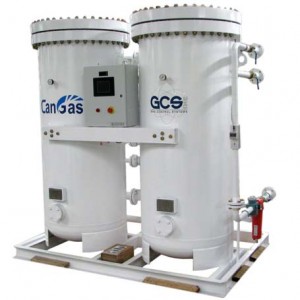
Model GCS PSA-3500 (Ext. Compressor not shown)
The various models of PSA nitrogen generator systems offered by GCS generate nitrogen at purities ranging from 95 – 99.999%, with a max pressure drop of only 1 bar. Various sizes are offered with flowrates ranging from 5cfm to >200cfm in order to meet your specific nitrogen needs.
Features
- Add the convenience of making your own nitrogen!
- Reliable, low-maintenance nitrogen production
- Standard touchscreen displays product purity, pressure, flow rate, and maintenance reminders
- Lower production cost than liquid N2
- Energy Efficient
- Estimated 80,000 hour Valve & CMS Lifespan
Compressed air is passed through a refrigerated air dryer and a four-step filtration process for optimal performance and lifespan of the PSA unit. An air buffer is incorporated for smooth supply of compressed air, thus reducing
fluctuation of load demands at the air compressor. The generator produces nitrogen with PSA (pressure swing adsorption) technology, which is a time proven nitrogen generation method. Nitrogen at the desired purity is delivered to the nitrogen buffer tank for smooth supply at a constant purity and flow rate. The nitrogen buffer tank is maintained at certain pressure, and is adjustable to your needs through a pressure regulator valve.
The principles of PSA nitrogen generation are adsorption and diffusion. Each gas has a characteristic adsorption rate that is adsorbed by the Carbon Molecular Sieve (CMS). The CMS has a large surface area that is covered in micropores and passageways. Since oxygen has a higher adsorption rate than nitrogen, when compressed air flows through the CMS, the nitrogen molecules are able to pass through this large surface freely, while oxygen molecules are adsorbed to these pores.
After the CMS is saturated with oxygen, it is depressurized to regenerate for the next cycle. We use two towers filled with CMS to produce a continuous stream of nitrogen.
During depressurization, the nitrogen of lower purity is transferred to the adjacent tower, which is called pressure equalization. Pressure equalization is key to higher efficiency and less energy consumption.
.

